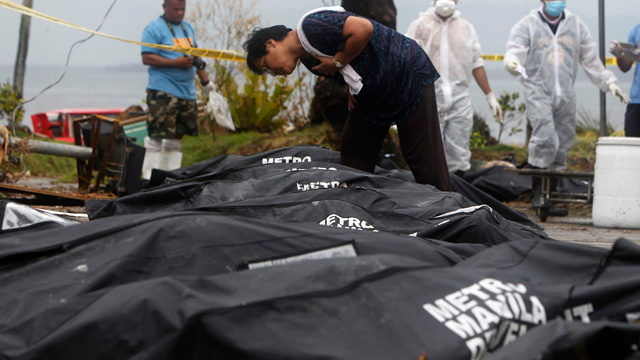
The Department of Health (DOH) has set up a quick system for managing the collection of bodies in the typhoon-ravaged areas of Leyte and Samar provinces.
The DOH has convened a meeting of forensic experts from the World Health Organization (WHO), the National Bureau of Investigation, and the University of the Philippines to establish the system that, it said, conforms with existing international standards on disaster victims identification.
Several teams, each composed of a forensic expert and four others including a photographer, will start work using the quick system on Saturday, the DOH said.
The Philippine Red Cross will support the teams by providing psychosocial support and preparing the communities for the process.
Photos, identifying marks and belongings, and appropriate samples for possible DNA testing will be collected when possible, considering the prevailing harsh conditions, the DOH said.
According to Health Secretary Enrique Ona, the identification process will not allow public viewing but surviving relatives will be asked to participate in the final identification of bodies at an appointed time.
“Hopefully, each team will be able to handle 40 dead bodies every day. Final identification of dead bodies will take a while but we appeal to the public for their patience and understanding,” Ona said in a statement.
After the identification procedure, the bodies will be temporarily buried according to prevailing protocol that will allow future investigations when necessary, he added.
A week after one of the strongest typhoons ever tore through the Philippines, bodies still lie where they fell or were washed up, the defining motif of a tragedy that has killed thousands.
The stench of bloated and discolored human flesh decomposing under the tropical sun hangs everywhere in the city of Tacloban, where wretched survivors and rescue workers cover their mouths to keep the cloying smell from their throats.
Hundreds have been collected, put into body bags and trucked off to wrecked municipal buildings to await burial in mass graves, a process that city authorities began on Thursday.
Officials and aid volunteers say those bodies that have been recovered are just the beginning, a small fraction of those that could be seen when the storm surge subsided. Many more, they say, lie under the mountains of debris.
“Leaving them (the bodies) just decaying on the roadside, uncollected, is next to unforgivable,” said Catholic priest Amadeo Alvero.
Officials initially said picking up the bodies had to take second place to the effort to help those still living, many in utter destitution, their homes swept away and with precious little food or clean drinking water.
But they also conceded they had simply been overwhelmed by the number of dead and had temporarily run out of body bags.
Echoing a fear expressed by many, Alvero said the dead could be the source of contagious disease.
“The government needs to act fast because this could also become a health issue,” he said.
In many affected areas, many bodies have yet to be discovered and retrieved. And almost all the bodies that have been retrieved remain unidentified and unburied.
There is a growing fear among the public that the bodies will cause illness. But Ona explained that dead bodies do not cause epidemics.
“Dead bodies do not pose immediate health risk. Those are cadavers and when you die, you are no longer infected. The bacteria dies with you,” he said.
“Most infectious germs do not survive beyond 48 hours. Body handlers can wear gloves when they handle bodies and must wash their hands as precautionary measure,” he added.
Teams have been dispatched to Tacloban from the justice department’s investigating arm and the national police’s crime laboratory.
They know they will not identify everybody they find straight away, but hope to collect enough evidence to allow that to be done later.
“On the scene, our doctors begin the documentation,” said Chief Supt. Liza Sabong, head of the Philippine National Police crime laboratory and part of the contingent sent to Tacloban.
“We tag them as male or female, they photograph them, list the belongings on the cadaver itself. We do fingerprinting. We measure the body and then they are placed in cadaver bags.”
This “processing” will allow any surviving relatives at a later date to identify the body, possibly through its clothes or appearance, she told Agence France-Presse (AFP).
But the sheer scale of the task is overwhelming.
Only 13 of the 182 bodies collected by Sabong’s group have been picked up by their relatives, she said. The rest have been left behind.
Tacloban on Thursday began mass burials of some of those bodies that had been bagged and laid out by the shattered City Hall.
The plan, said Mayor Alfred Romualdez, was that all those whose name and family were known would be placed into one huge pit. The unidentified rest would go into a separate mass grave.
Romualdez, who has been an outspoken critic of the rescue effort, said he believed three-quarters of all bodies collected had still not been claimed by family. In these circumstances, mass burials were the only option.
“Let’s get the bodies out of the streets,” he said. “They are creating an atmosphere of fear and depression.”
The head of the justice department’s forensics division, Wilfredo Tierra, said the collective burial was only intended as a stopgap measure.
“They will be buried temporarily in a shallow, mass grave and when everything has settled down and the peace and order situation is not an issue anymore, then we will proceed with the proper disaster victim identification,” he told AFP
Saturday 16 November 2013
http://newsinfo.inquirer.net/528123/health-department-moves-to-collect-identify-bodies

0 comments:
Post a Comment